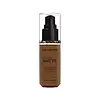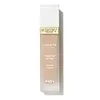What's inside
What's inside
 Key Ingredients
Key Ingredients

 Benefits
Benefits

 Concerns
Concerns

 Ingredients Side-by-side
Ingredients Side-by-side

Water
Skin ConditioningCyclopentasiloxane
EmollientBeeswax
Emulsion StabilisingStearyl Dimethicone
EmollientIsododecane
EmollientCetyl Ethylhexanoate
EmollientMicrocrystalline Wax
Emulsion StabilisingCetyl PEG/PPG-10/1 Dimethicone
EmulsifyingGlyceryl Laurate
EmollientPolyglyceryl-4 Oleate
EmulsifyingMica
Cosmetic ColorantDisteardimonium Hectorite
StabilisingPhenoxyethanol
PreservativeMethylparaben
PreservativeEthylparaben
PreservativeButylparaben
MaskingPropylparaben
PreservativeTocopheryl Acetate
AntioxidantAscorbyl Palmitate
AntioxidantPropylene Glycol
HumectantChamomilla Recutita Extract
Skin ConditioningPropylene Carbonate
SolventSodium Hyaluronate
HumectantCI 77491
Cosmetic ColorantCI 77492
Cosmetic ColorantCI 77499
Cosmetic ColorantCI 77891
Cosmetic ColorantWater, Cyclopentasiloxane, Beeswax, Stearyl Dimethicone, Isododecane, Cetyl Ethylhexanoate, Microcrystalline Wax, Cetyl PEG/PPG-10/1 Dimethicone, Glyceryl Laurate, Polyglyceryl-4 Oleate, Mica, Disteardimonium Hectorite, Phenoxyethanol, Methylparaben, Ethylparaben, Butylparaben, Propylparaben, Tocopheryl Acetate, Ascorbyl Palmitate, Propylene Glycol, Chamomilla Recutita Extract, Propylene Carbonate, Sodium Hyaluronate, CI 77491, CI 77492, CI 77499, CI 77891
Water
Skin ConditioningDicaprylyl Carbonate
EmollientC9-12 Alkane
SolventGlycerin
HumectantIsododecane
EmollientCaprylyl Methicone
Skin ConditioningButylene Glycol
HumectantIsodecyl Neopentanoate
EmollientDimethicone/Vinyl Dimethicone Crosspolymer
Skin ConditioningDimethicone
EmollientBoron Nitride
AbsorbentPentylene Glycol
Skin ConditioningPolyglyceryl-4 Isostearate
EmulsifyingCetyl PEG/PPG-10/1 Dimethicone
EmulsifyingHexyl Laurate
EmollientHydrogenated Polydicyclopentadiene
Sodium Chloride
MaskingSaccharide Isomerate
HumectantPanthenol
Skin ConditioningTocopheryl Acetate
AntioxidantHydrolyzed Soy Protein
HumectantAdenosine
Skin ConditioningPrunus Serrulata Flower Extract
Skin ConditioningSalix Alba Leaf Extract
Skin ConditioningAlgae Extract
EmollientAlbizia Julibrissin Bark Extract
MaskingVitis Vinifera Leaf Extract
Skin ConditioningPolysilicone-11
Synthetic Fluorphlogopite
Stearalkonium Hectorite
Gel FormingHydrogenated Lecithin
EmulsifyingDimethiconol
EmollientPropylene Carbonate
SolventSilica
AbrasiveIsoceteth-10
EmulsifyingCitric Acid
BufferingSodium Citrate
BufferingEthylhexylglycerin
Skin ConditioningParfum
MaskingSorbic Acid
PreservativePhenoxyethanol
PreservativeSodium Benzoate
MaskingPotassium Sorbate
PreservativeCI 77891
Cosmetic ColorantIron Oxides
Mica
Cosmetic ColorantWater, Dicaprylyl Carbonate, C9-12 Alkane, Glycerin, Isododecane, Caprylyl Methicone, Butylene Glycol, Isodecyl Neopentanoate, Dimethicone/Vinyl Dimethicone Crosspolymer, Dimethicone, Boron Nitride, Pentylene Glycol, Polyglyceryl-4 Isostearate, Cetyl PEG/PPG-10/1 Dimethicone, Hexyl Laurate, Hydrogenated Polydicyclopentadiene, Sodium Chloride, Saccharide Isomerate, Panthenol, Tocopheryl Acetate, Hydrolyzed Soy Protein, Adenosine, Prunus Serrulata Flower Extract, Salix Alba Leaf Extract, Algae Extract, Albizia Julibrissin Bark Extract, Vitis Vinifera Leaf Extract, Polysilicone-11, Synthetic Fluorphlogopite, Stearalkonium Hectorite, Hydrogenated Lecithin, Dimethiconol, Propylene Carbonate, Silica, Isoceteth-10, Citric Acid, Sodium Citrate, Ethylhexylglycerin, Parfum, Sorbic Acid, Phenoxyethanol, Sodium Benzoate, Potassium Sorbate, CI 77891, Iron Oxides, Mica
Ingredients Explained
These ingredients are found in both products.
Ingredients higher up in an ingredient list are typically present in a larger amount.
This ingredient is a high molecular weight silicone. It has emulsifying and skin conditioning properties.
Ci 77891 is a white pigment from Titanium dioxide. It is naturally found in minerals such as rutile and ilmenite.
It's main function is to add a white color to cosmetics. It can also be mixed with other colors to create different shades.
Ci 77891 is commonly found in sunscreens due to its ability to block UV rays.
Learn more about CI 77891Isododecane is a fragrance, emollient, and solvent.
As an emollient, it helps your skin stay soft and hydrated. Emollients help trap moisture into your skin.
Isododecane's role as a solvent makes it a great texture enhancer. It spreads smoothly on skin and does not leave a sticky feeling behind. Isododecane also helps prevent color transfer in makeup products.
Isododecane is not absorbed into skin.
Learn more about IsododecaneMica is a naturally occurring mineral used to add shimmer and color in cosmetics. It can also help improve the texture of a product or give it an opaque, white/silver color.
Serecite is the name for very fine but ragged grains of mica.
This ingredient is often coated with metal oxides like titanium dioxide. Trace amounts of heavy metals may be found in mica, but these metals are not harmful in our personal products.
Mica has been used since prehistoric times throughout the world. Ancient Egyptian, Indian, Greek, Roman, Aztec, and Chinese civilizations have used mica.
Learn more about MicaPhenoxyethanol is a preservative that has germicide, antimicrobial, and aromatic properties. Studies show that phenoxyethanol can prevent microbial growth. By itself, it has a scent that is similar to that of a rose.
It's often used in formulations along with Caprylyl Glycol to preserve the shelf life of products.
This ingredient is a solvent. It helps dissolve active ingredients and alter the texture of products.
Propylene Carbonate is commonly used in makeup and with clay, such as montmorillonite or bentonite.
Studies show this ingredient to be safe for cosmetics. When it is undiluted, it can cause skin irritation. (It is always diluted in skincare and makeup). This ingredient is water-soluble.
Propylene Carbonate is created from propylene glycol and carbonic acid.
Learn more about Propylene CarbonateTocopheryl Acetate is AKA Vitamin E. It is an antioxidant and protects your skin from free radicals. Free radicals damage the skin by breaking down collagen.
One study found using Tocopheryl Acetate with Vitamin C decreased the number of sunburned cells.
Tocopheryl Acetate is commonly found in both skincare and dietary supplements.
Learn more about Tocopheryl AcetateWater. It's the most common cosmetic ingredient of all. You'll usually see it at the top of ingredient lists, meaning that it makes up the largest part of the product.
So why is it so popular? Water most often acts as a solvent - this means that it helps dissolve other ingredients into the formulation.
You'll also recognize water as that liquid we all need to stay alive. If you see this, drink a glass of water. Stay hydrated!
Learn more about Water